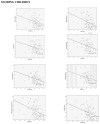Sleep hygiene and problem behaviors in snoring and non-snoring school-age children
- PMID: 22647496
- PMCID: PMC3430873
- DOI: 10.1016/j.sleep.2012.03.013
Sleep hygiene and problem behaviors in snoring and non-snoring school-age children
Abstract
Objectives: The effects of sleep-disordered breathing, sleep restriction, dyssomnias, and parasomnias on daytime behavior in children have been previously assessed. However, the potential relationship(s) between sleep hygiene and children's daytime behavior remain to be explored. The primary goal of this study was to investigate the relationship between sleep hygiene and problematic behaviors in non-snoring and habitually snoring children.
Methods: Parents of 100 5- to 8-year-old children who were reported to snore "frequently" to "almost always," and of 71 age-, gender-, and ethnicity-matched children who were reported to never snore participated in this study. As part of a larger, ongoing study, children underwent nocturnal polysomnography and parents were asked to complete the Children's Sleep Hygiene Scale (CSHS) and the Conners' Parent Rating Scales-Revised (CPRS-R:L).
Results: In the snoring group, strong negative correlations (r=-.39, p<.001) between the CSHS overall sleep hygiene score and the CPRS-R:L DSM-IV total scores emerged. Additionally, several subscales of the CSHS and CPRS-R:L were significantly correlated (p-values from <.000 to .004) in snoring children. No significant correlations were observed between the CSHS and the CPRS-R:L in the non-snoring children.
Conclusions: Parental reports of behavioral patterns in snoring children indicate that poorer sleep hygiene is more likely to be associated with behavior problems, including hyperactivity, impulsivity, and oppositional behavior. In contrast, no significant relationships between sleep hygiene and problem behaviors emerged among non-snoring children. These results indicate that children at risk for sleep disordered breathing are susceptible to daytime behavior impairments when concurrently coupled with poor sleep hygiene practices.
Copyright © 2012 Elsevier B.V. All rights reserved.
Conflict of interest statement
No off label use of products is described, and the authors have no conflict of interest to disclose.
Figures



Similar articles
-
Symptoms of inattention and hyperactivity in children with habitual snoring: evidence from a community-based study in Istanbul.Child Care Health Dev. 2005 Nov;31(6):707-17. doi: 10.1111/j.1365-2214.2005.00561.x. Child Care Health Dev. 2005. PMID: 16207229
-
Neurobehavioral Outcomes in School-Aged Children with Primary Snoring.Arch Clin Neuropsychol. 2020 May 22;35(4):401-412. doi: 10.1093/arclin/acz053. Arch Clin Neuropsychol. 2020. PMID: 31813961
-
Symptoms of sleep-disordered breathing in 5-year-old children are associated with sleepiness and problem behaviors.Pediatrics. 2003 Oct;112(4):870-7. doi: 10.1542/peds.112.4.870. Pediatrics. 2003. PMID: 14523179
-
Loudness of snoring, not apnea-hypopnea index, is associated with hyperactivity behavior in snoring children and adolescents.Sleep Med. 2025 Mar;127:43-48. doi: 10.1016/j.sleep.2025.01.006. Epub 2025 Jan 6. Sleep Med. 2025. PMID: 39787820
-
The impact of sleep-disordered breathing on cognition and behavior in children: a review and meta-synthesis of the literature.Otolaryngol Head Neck Surg. 2004 Dec;131(6):814-26. doi: 10.1016/j.otohns.2004.09.017. Otolaryngol Head Neck Surg. 2004. PMID: 15577774 Review.
Cited by
-
Sleep, Classroom Behavior, and Achievement Among Children of Color in Historically Disinvested Neighborhoods.Child Dev. 2021 Sep;92(5):1932-1950. doi: 10.1111/cdev.13590. Epub 2021 May 27. Child Dev. 2021. PMID: 34041742 Free PMC article.
-
Sleep Hygiene Practices and Bedtime Resistance in Low-Income Preschoolers: Does Temperament Matter?Behav Sleep Med. 2015;13(5):412-23. doi: 10.1080/15402002.2014.940104. Epub 2014 Sep 15. Behav Sleep Med. 2015. PMID: 25221914 Free PMC article.
-
Sleep disturbances and behavior problems in children with and without arthritis.J Pediatr Nurs. 2014 Jul-Aug;29(4):321-8. doi: 10.1016/j.pedn.2014.03.022. Epub 2014 Mar 15. J Pediatr Nurs. 2014. PMID: 24704178 Free PMC article.
-
Sleep Hygiene and Sleep Outcomes in a Sample of Urban Children With and Without Asthma.J Pediatr Psychol. 2017 Sep 1;42(8):825-836. doi: 10.1093/jpepsy/jsx052. J Pediatr Psychol. 2017. PMID: 28369539 Free PMC article.
-
The Association Between Sleep Problems and Attentional Network Functions in Patients with Self-Limited Epilepsy with Centrotemporal Spikes.Nat Sci Sleep. 2024 Jun 10;16:751-760. doi: 10.2147/NSS.S460558. eCollection 2024. Nat Sci Sleep. 2024. PMID: 38894978 Free PMC article.
References
-
- Ferber R. The sleepless child. In: Guilleminault C, editor. Sleep and its disorders in children. New York: Raven Press; 1987. pp. 141–163.
-
- Mindell JA, Kuhn B, Lewin DS, Meltzer LJ, Sadeh A. Behavioral treatment of bedtime problems and night wakings in infants and young children. Sleep. 2006;29:1263–1276. - PubMed
-
- Donaldson DL, Owens JA. Sleep and sleep problems. In: Bear GG, Minke KM, editors. Children’s needs III: Development, prevention, and intervention. Washington DC: National Association of School Psychologists; 2006. pp. 1025–1039.
-
- Stein MA, Mendelsohn J, Obermeyer WH, Amromin J, Benca R. Sleep and behavior problems in school-aged children. Pediatrics. 2001;107:60–69. - PubMed
-
- Corkum P, Tannock R, Moldofsky H. Sleep disturbance in children with attention-deficit hyperactivity disorder. J Am Acad Child Adolesc Psychaitry. 1991;37:637–646. - PubMed
Publication types
MeSH terms
Grants and funding
LinkOut - more resources
Full Text Sources
Medical
Research Materials

